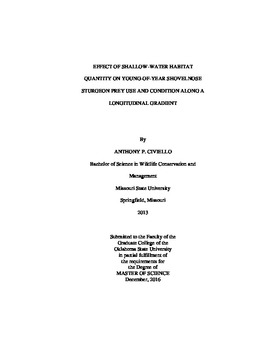| dc.contributor.advisor | Long, James M. | |
| dc.contributor.author | Civiello, Anthony P. | |
| dc.date.accessioned | 2018-06-29T14:41:15Z | |
| dc.date.available | 2018-06-29T14:41:15Z | |
| dc.date.issued | 2016-12-01 | |
| dc.identifier.uri | https://hdl.handle.net/11244/300387 | |
| dc.description.abstract | The lower Missouri River has been highly modified and it is hypothesized that the loss of shallow-water habitat (SWH) has decreased prey availability, negatively affecting young-of-year (YOY) sturgeon. Young-of-year sturgeon (Scaphirhynchus spp.) from five reaches of the lower Missouri River that varied in amount of SWH (47 to 295 ha) were sampled bi-monthly from May through October in 2014 and 2015. For each site, I analyzed prey use and condition in relation to the amount of SWH along a longitudinal gradient of the river. I analyzed 506 YOY shovelnose sturgeon in 2014 and 569 in 2015 (14 to 120 mm FL) and found diet items were restricted to three macroinvertebrate orders: diptera, ephemeroptera, and trichoptera. In 2015, YOY shovelnose sturgeon consumed nearly twice as many prey as in 2014 and had many fewer instances of empty stomachs. Regarding the predominant prey type, number of diptera larvae eaten peaked at middle reaches and moderate amounts of SWH in 2014 and high numbers were consumed at sites further downstream and as SWH increased in 2015. The number of diptera larvae consumed grew exponentially with length, however, in 2015, rate of diptera larvae consumed was least in high amounts of SWH. Prey quantity did not appear to be limited and factors beyond amounts of SWH appear to be affecting prey use and survivorship of YOY shovelnose sturgeon. The highest percent lipid (i.e. body condition) for YOY shovelnose sturgeon was at lengths ?40mm, attributed to assimilation of the yolk sac. Condition was best explained by location along the river continuum, increasing with increased distance upstream (r2 ? 0.27). An interannual influence was observed with average percent lipid in lengths 41-120mm being lower in 2014 than in 2015. Emaciated and healthy control YOY shovelnose sturgeon were acquired to compare to the condition of wild-caught fish. In 2014, length categories >41mm were not statistically different from emaciated specimens and, in 2015, only length category 101-120mm differed from control specimens (P ? 0.05). These results provide the first description of YOY sturgeon prey use and condition at a large spatial scale along the lower Missouri River. | |
| dc.format | application/pdf | |
| dc.language | en_US | |
| dc.rights | Copyright is held by the author who has granted the Oklahoma State University Library the non-exclusive right to share this material in its institutional repository. Contact Digital Library Services at lib-dls@okstate.edu or 405-744-9161 for the permission policy on the use, reproduction or distribution of this material. | |
| dc.title | Effect of Shallow-water Habitat Quantity on Young-of-year Shovelnose Sturgeon Prey Use and Condition along a Longitudinal Gradient | |
| dc.contributor.committeeMember | Dzialowski, Andrew R. | |
| dc.contributor.committeeMember | Belden, Jason B. | |
| osu.filename | Civiello_okstate_0664M_14891.pdf | |
| osu.accesstype | Open Access | |
| dc.description.department | Natural Resources and Ecology Management | |
| dc.type.genre | Thesis | |
| dc.type.material | text | |
